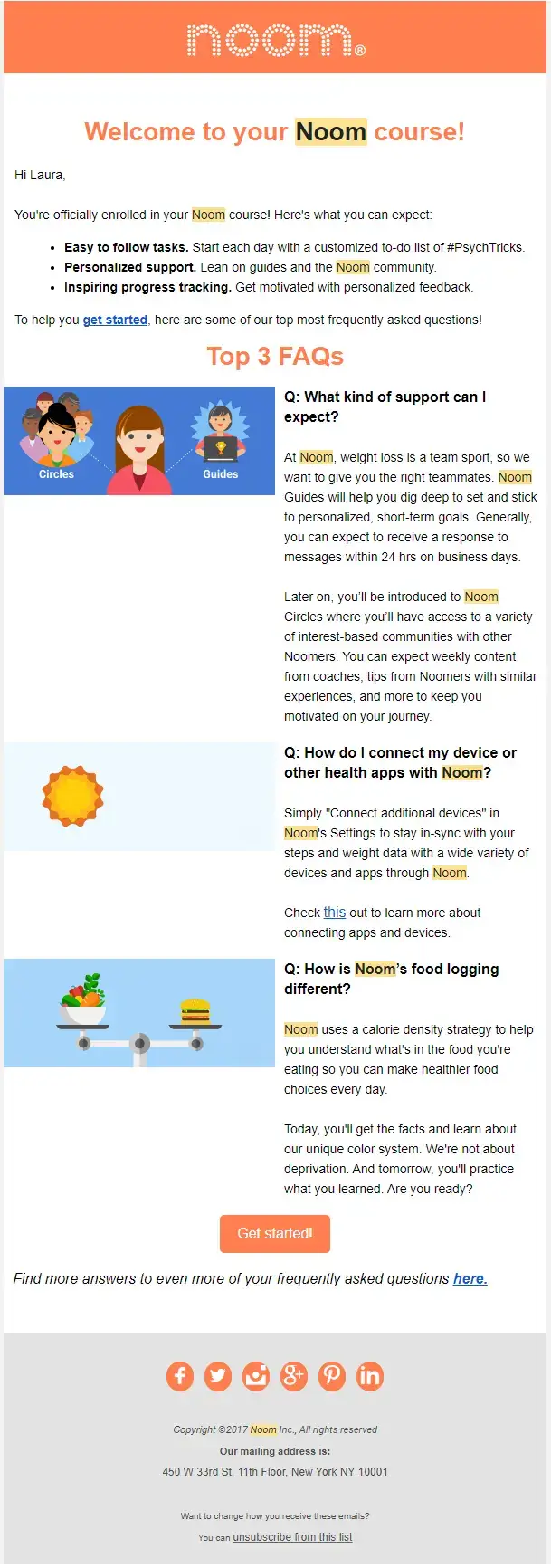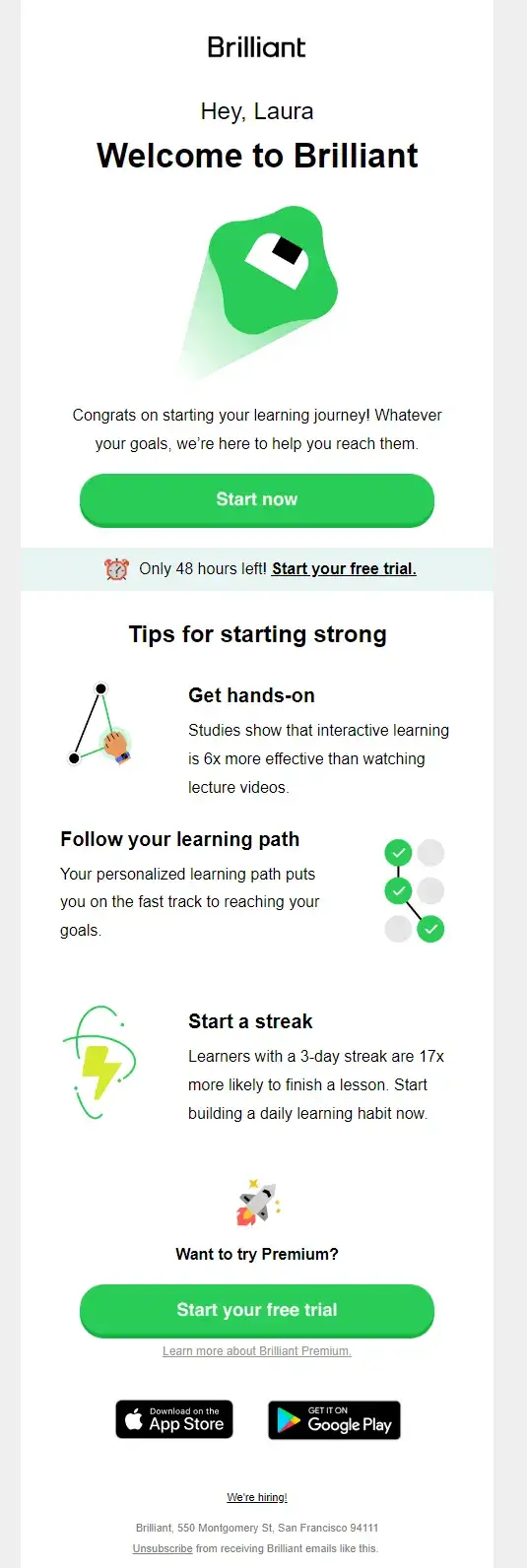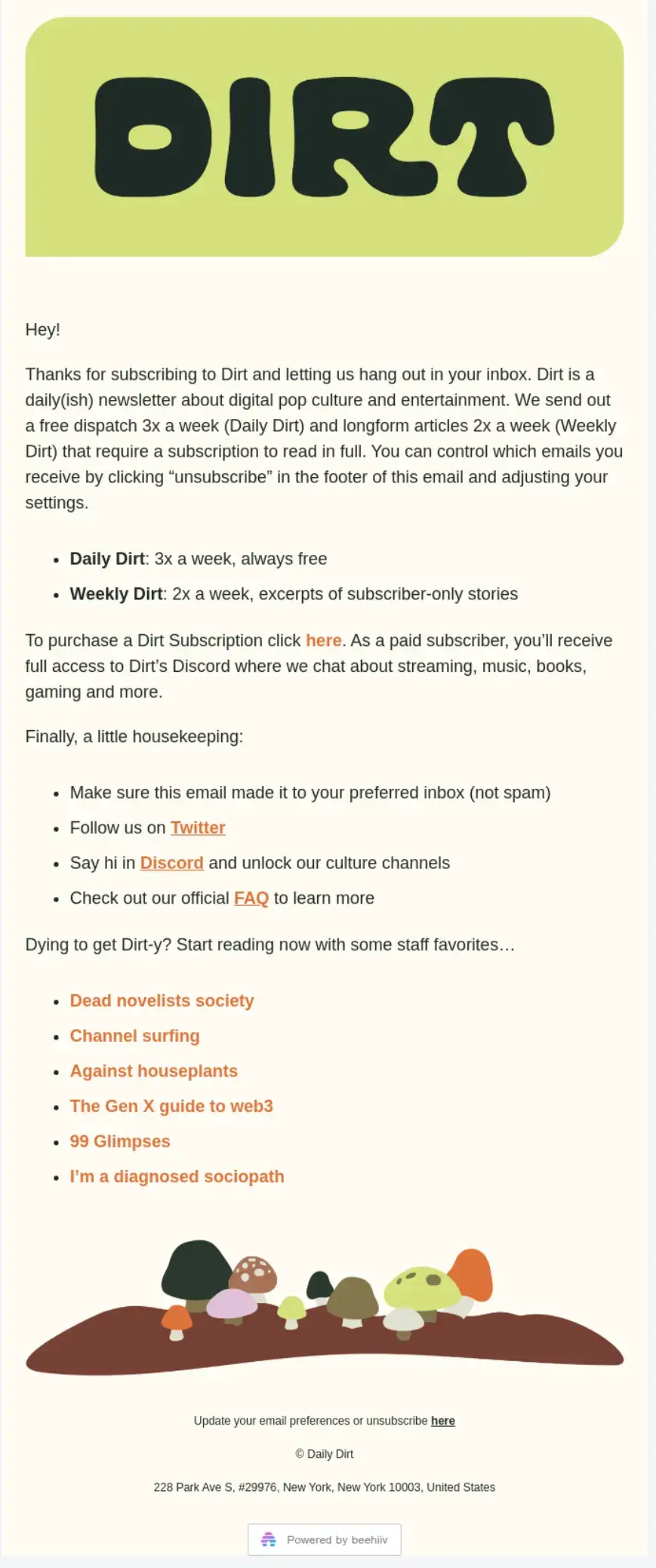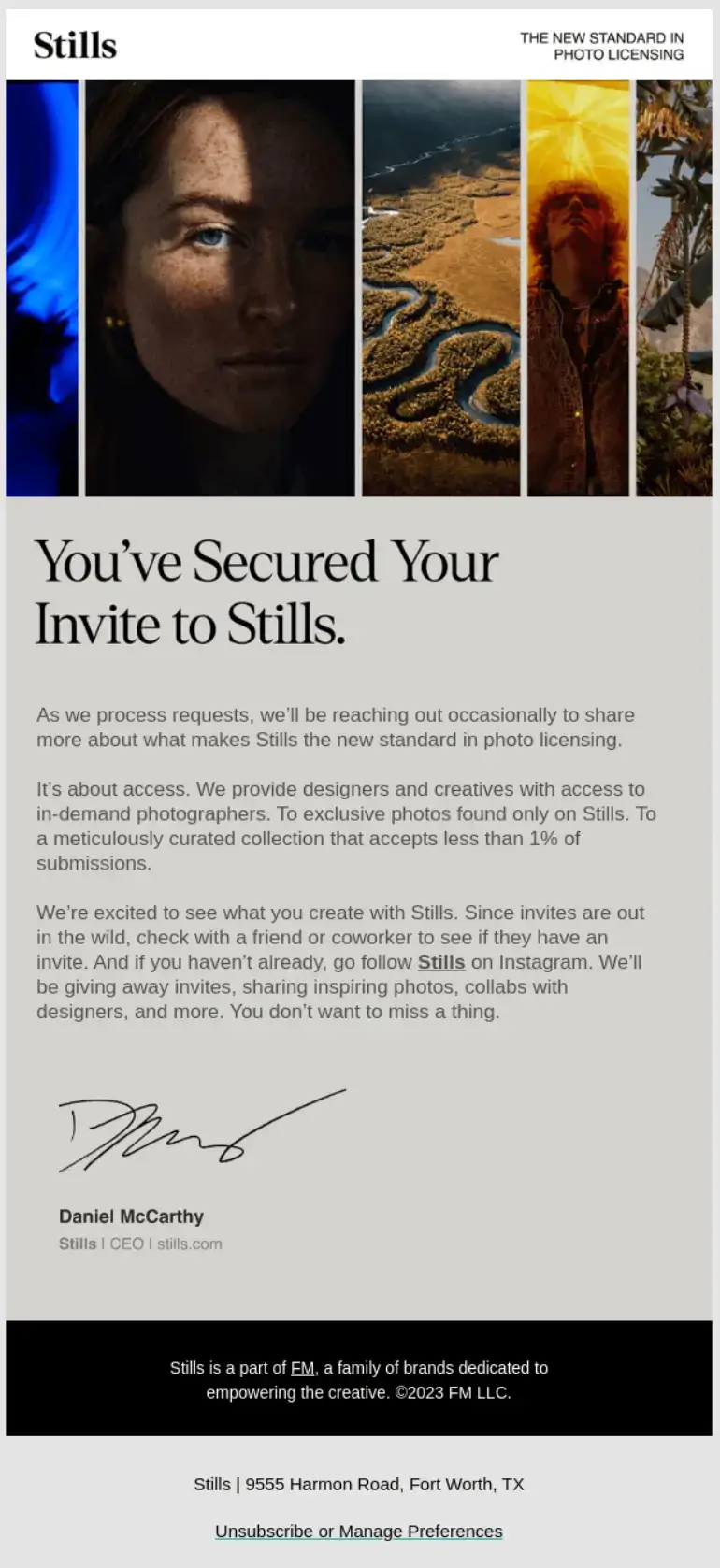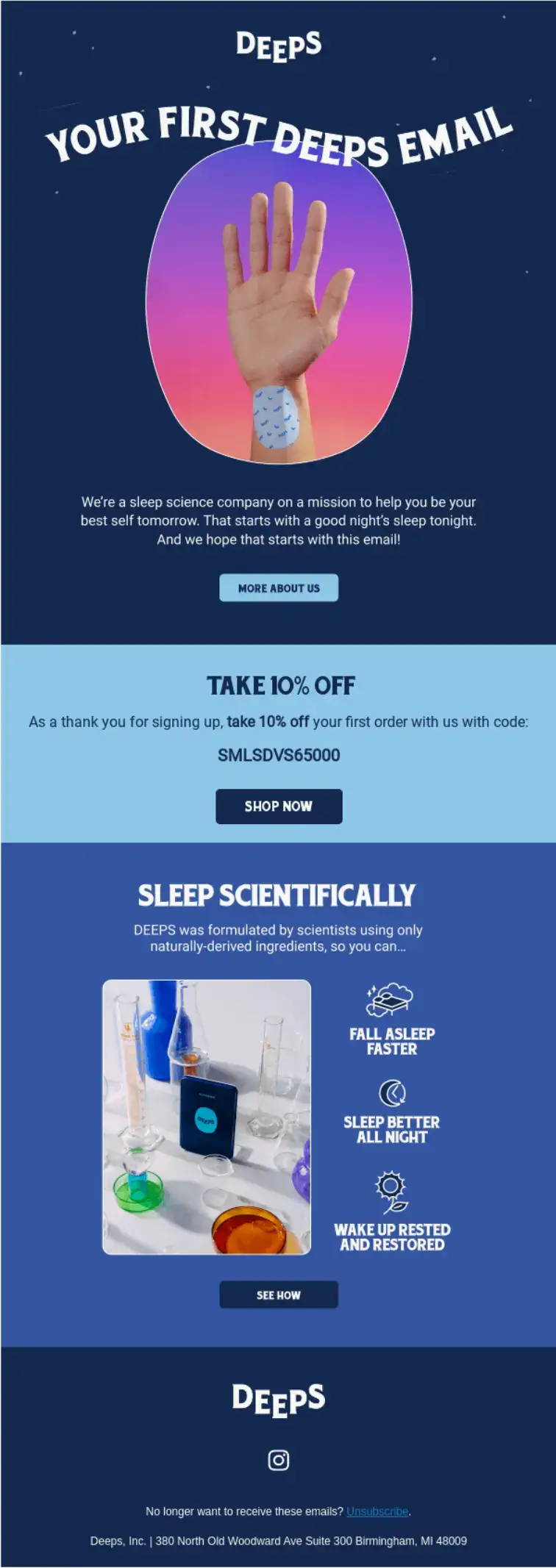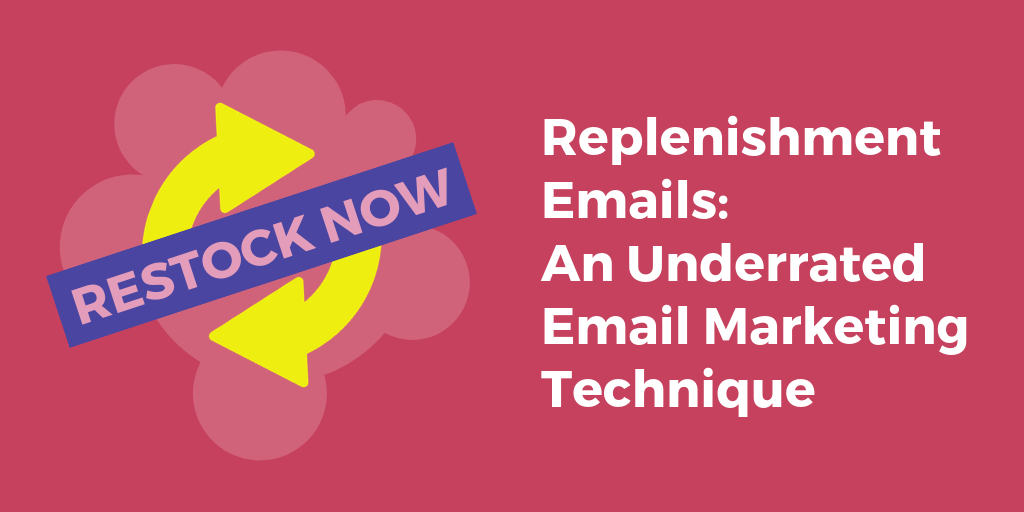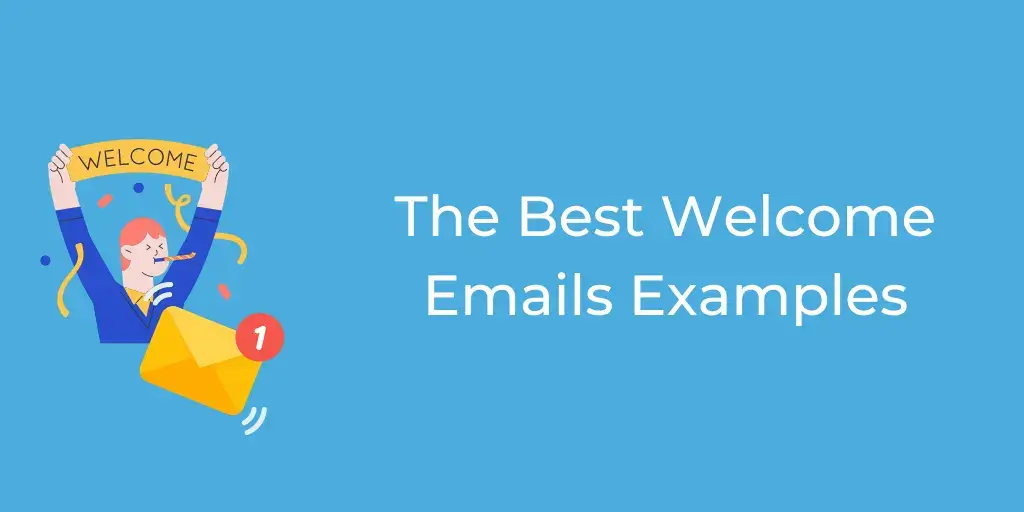
Quick links
In email marketing, the welcome email is your golden opportunity to make a great first impression.
Whether you’re welcoming new subscribers, customers, or members to your community, a well-crafted welcome email can set the tone for a long and fruitful relationship.
In this guide, we’re diving into the 15 best welcome email examples of 2024, showcasing how top brands are getting it right and how you can, too.
What is a welcome email?
A welcome email is the first official communication you send to someone who has subscribed to your newsletter, signed up for your service, or made a purchase.
It’s your chance to make a lasting impression and set the tone for your relationship with the recipient.
This email is essential because it confirms the subscription, thanks the recipient for joining, and often provides useful information or an incentive to engage further with your brand.
Why is a welcome email important?
This simple email might seem like something you can skip over, but they’re a great way to get the ball rolling.
- First impressions matter: The welcome email is often the first interaction a new subscriber or customer has with your brand, and they have an extremely high open rate, averaging at more than 91%.. A well-crafted welcome email can positively enhance brand perception and encourage further engagement.
- High engagement rates: On top of high open rates, welcome emails typically have good click-through rates (about 27%) because they’re expected by the recipient. This makes them a prime opportunity to deliver key messages and CTAs.
- Set expectations: With 74% of subscribers expecting to receive a welcome email, not sending one will disappoint a lot of people right off the bat.This email also allows you to inform the recipient about what they can expect from your communications, such as the frequency of emails, types of content, and any special offers or benefits they can look forward to.
How to write a welcome email: A simple guide
Writing emails can be tough work. Use these steps to help get started. Keep in mind that you don’t need every element to have a successful welcome email, and be sure to add your own flair and creativity.
- Start with a warm greeting:
- Use a friendly and welcoming tone. Personalise the email with the recipient’s name to make it feel more tailored.
- Example: “Hi [Name], Welcome to [Brand]!”
- Express gratitude:
- Thank the recipient for subscribing, signing up, or making a purchase. This simple act of appreciation can build a positive connection.
- Example: “Thank you for joining our community!”
- Introduce your brand:
- Provide a brief introduction to your brand or service. Explain what makes you unique and why the recipient should be excited to be a part of your community.
- Example: “At [Brand], we’re all about [brief description of what you do/mission statement].”
- Highlight the benefits:
- Let the recipient know what they can expect from being on your list. Mention any exclusive content, special offers, or resources they’ll receive.
- Example: “As a subscriber, you’ll get early access to new products, special discounts, and more!”
- Include a clear Call to Action (CTA):
- Encourage the recipient to take the next step, whether it’s exploring your website, following you on social media, or making a purchase with a discount code.
- Example: “Get started with 10% off your first purchase – use code WELCOME10 at checkout!”
- Provide contact information:
- Offer a way for the recipient to get in touch if they have any questions or need support. This adds a personal touch and builds trust.
- Example: “Need help? Just reply to this email or reach out to our support team at [email address].”
- End with a warm closing:
- Finish the email with a friendly sign-off that reinforces the positive tone of your message.
- Example: “Cheers, The [Brand] Team”
Following these steps is a surefire way to create a welcome email that not only introduces your brand, but also engages your new subscribers from the very start.
15 excellent welcome email examples
From brand stories to exclusive discounts and everything in between, these welcome email examples are sure to inspire your next great email creation.
1. Noom
Noom, a popular weight loss app, sends out this personalised welcome email with the answers to several common questions.
The use of FAQs, personalization, images and graphics, and a general ‘Get Started’ CTA all work well in this email.
While having one CTA is likely to increase CTR by 371%, it could be more effective if the language or layout was more direct and eye-catching.
2. Fix8
Fix8, providing the world with tasty kombucha in a can, comes to your inbox with this delightfully colourful discount and social proof welcome email.
Telling the audience what users think about Fix8 in easy to read bites and having an exclusive discount code/link both before and after their customer reviews are a perfect way to increase sales and CTR.
The use of more subtle CTAs and social links at the bottom is also a nice touch that can snag visitors who might not be interested in shopping at the moment. With 85% of marketers using social links as email footers, this is an easy-to-implement step that will likely boost engagement.
However, the grammar and punctuation in the reviews makes them look a bit scammy and unprofessional, and there are no links to these claims.
3. Brilliant
Dedicated to spreading knowledge through short, daily lessons, Brilliant uses a time-sensitive offer and starter tips in this minimalistic welcome email.
Adding a sense of urgency (48 hours left) to join a free trial offer works well to encourage customers to sign up, as conversion rates rise as much as 22% with time-sensitive CTAs. Tips on being successful with the app are a nice touch as well.
Unfortunately the CTAs at the bottom are a bit confusing. Is the free trial for the Premium version or the regular version? There’s no clarification, and further investigation on their website shows there is no forever-free version of Brilliant.
Having a clear CTA is paramount in all types of marketing, and this just needs a little tweaking to be perfect.
4. Dirt
For pop culture enthusiasts there’s the near-daily newsletter, Dirt. This welcome email sets up user expectations and gives a nice introduction into what type of content to expect.
There are a lot of CTAs in this email, but for a newsletter this is appropriate. You’ve already taken the main action they want you to do (subscribe to the newsletter), and this email is just to introduce you to more content.
5. Lonely Planet
Travel gurus Lonely Planet introduce new subscribers with this well-written, thoughtful welcome email that has a few key elements: a brand promise, what to expect, and an exclusive discount.
The writing itself stands out here, showing a lot of personality and reassurance to the customer, serving as both a welcome message and a brand promise. A 20% discount is also a sweet way to welcome new users.
A couple things that could be improved are the CTA placement – having it at the bottom may lower click-through and conversion rates – and the overall length might be considered too long by some.
6. Mecene
Mecene, a vitamin and supplement shop, has a simplistic, no nonsense welcome email for users who wish to receive marketing emails.
What works here is the bullet point format and the product placement, but the products would benefit from having a description, and some bolding in the text to draw the reader’s attention.
7. Allie Stark Wellness
Allie Stark Wellness, a mental health wellness service, incorporates several methods to introduce users to her brand and leave them with a positive impression.
A note from the owner herself gives a warm and personal feeling, followed by a short but inspirational ‘what to expect’ section. Something unique here is Allie’s favourites section, which does not link to her own website, but still provides relevant and useful content.
On the other hand, the main CTA to book an intro call could use some more information – what happens on an intro call, and what value does it provide? Adding a little more detail would likely increase engagement rates.
8. Flodesk
A welcome email about welcome emails? How meta! Flodesk offers a suite of software tools to help grow your digital presence or business, including email marketing capabilities.
Flodesk’s how-to guide acts as both a welcome email from the company and a product guide, killing two birds with one stone. The process is simple and easy to use, making for an impressive and stand-out email.
Adding CTAs after every step might spread out clicks, but it’s a great way to showcase all your product has to offer.
9. Stills
Next we have an example from Stills, an exclusive photo licensing service. This email is short and simple, letting the user know they’re secured an invite to the platform.
Having a CEO-backed letter is a great method, and having visually striking images with short copy captures attention without taking up much time. However, the only CTA available is to follow them on Instagram.
10. Goop Kitchen
Goop Kitchen’s welcome email does a great job of setting the stage with a clear mission statement and a simple explanation of how their service works.
They also highlight some of their top menu items with beautiful product placement, which is an effective way to entice new customers.
However, the only CTA in the email is to follow them on Instagram. To improve engagement, they could include links to their recipe catalogue or other parts of their website to encourage deeper exploration.
11. Lomi
This company provides easy at-home composting for the eco-minded consumer. Lomi’s welcome email is visually appealing with its simple graphics and a generous discount offer.
Emails with offers can generate 30% more revenue per email than emails without an offer, so including a discount is an excellent sales strategy.
However, the email includes three clickable links in a very short space, which could dilute the impact of each one.
Reducing the number of links could streamline the message. Additionally, providing resources on what to do with the compost created by their product or offering tips and tricks would add extra value for their readers.
12. Material Kitchen
Material Kitchen’s welcome email exudes quality, featuring a short letter from the founders, a 30-day trial offer, and a lifelong guarantee on their high-end cookware.
While the email is strong, it could benefit from a bit of personalization or warmth in the language, which would make the recipient feel even more special and connected to the brand.
13. Burrow
Although not a traditional welcome email, Burrow’s “company birthday” email stands out with a timeline of their history and furniture collection releases.
The discount code is placed right at the top for easy access, which is great for those who don’t want to scroll.
The inclusion of links to their various furniture collections is also a smart move, driving traffic to different parts of their website.
14. Winnie Lou
Winnie Lou’s welcome email for their dog treat line effectively highlights what sets their products apart: premium ingredients.
This emphasis on quality helps demonstrate their market value, and the inclusion of a discount code sweetens the deal for new customers.
15. Deeps
Deeps, a sleep aid company, keeps their welcome email short and sweet. The email features concise copy with two strong CTAs: one to “see how it works” and another to “shop.”
This approach is effective, but they could improve it by showcasing other products through images to give recipients more options right off the bat.
Welcome email templates
To help you get started, here are five different types of welcome email templates, each catering to a specific purpose and style. These examples will give you a solid foundation to create personalised, engaging emails that hit home with your new subscribers.
Template 1: The brand/owner story
This template is perfect for introducing new subscribers to your brand’s story, mission, and the people behind the scenes. It’s ideal for small businesses or personal brands looking to build a strong, personal connection with their audience.
Subject Line: Welcome to [Your Brand] – Here’s Our Story
Email Body:
Hi [Name],
Welcome to [Your Brand]! We’re so glad to have you with us.
I’m [Your Name], the founder of [Your Brand], and I wanted to take a moment to share a bit of our story with you.
[Insert brief story about how your brand started, your mission, and what drives you.]
We believe that [Your Brand’s mission statement or core values]. We’re excited to have you join us on this journey, and we can’t wait to share our latest products, stories, and more with you.
Thank you for being part of our community. If you ever have any questions or just want to chat, feel free to reply to this email—I’d love to hear from you!
Warm regards,
[Your Name]
Founder of [Your Brand]
Template 2: The discount offer
This template is designed to encourage immediate action by offering a special discount or incentive to new subscribers. It’s a common go-to for e-commerce businesses wanting to drive first-time purchases.
Subject Line: Welcome! Here’s 20% Off Your First Order
Email Body:
Hello [Name],
Thanks for joining [Your Brand]! We’re thrilled to have you here, and to show our appreciation, we’d like to offer you 20% off your first purchase. Use code WELCOME20 at checkout.
Whether you’re looking for [popular products or categories], we’ve got something special just for you.
[Insert an eye-catching image of products with the discount code prominently displayed.]
Ready to shop? Click the link below and start exploring!
[Shop Now CTA]
We’re here if you have any questions or need recommendations. Just reply to this email or contact us at [email address].
Happy shopping,
The [Your Brand] Team
Template 3: The content introduction
This template is a good fit for businesses that want to engage new subscribers with valuable content, such as a blog, eBook, or video series. It’s ideal for content creators, bloggers, or educational platforms.
Subject Line: Welcome! Here’s Your First [Blog Post, Video, eBook]
Email Body:
Hi [Name],
Welcome to [Your Brand]! We’re excited to have you on board.
To kick things off, we’ve prepared something special just for you. Here’s your first piece of content from us: [Title of Blog Post, Video, or eBook].
[Include a brief description of the content and why it’s valuable.]
[Link to the content with a CTA, such as “Read Now” or “Watch Now”]
We’ll be sending you more great content in the coming weeks, so stay tuned! In the meantime, if you have any questions or just want to chat, feel free to reply to this email.
Enjoy,
The [Your Brand] Team
Template 4: The social media connect
This template encourages new subscribers to connect with your brand on social media, helping to build a broader relationship across multiple platforms. It’s great for brands that are active on social media and want to grow their following.
Subject Line: Let’s Stay Connected! Join Us on Social Media
Email Body:
Hi [Name],
Welcome to [Your Brand]!
We’re so glad you’re here and would love to connect with you on social media. Follow us on [platforms] to get the latest updates, behind-the-scenes looks, and special offers.
[Insert social media icons with links to your profiles.]
By following us, you’ll be the first to know about [what you post on social media—special offers, new arrivals, etc.].
See you online!
The [Your Brand] Team
Template 5: The onboarding series starter
This template is perfect for SaaS companies or services that require a bit of onboarding. It introduces the first step in a series of emails that will guide the user through getting started with your service.
Subject Line: Welcome to [Your Brand]! Let’s Get Started
Email Body:
Hello [Name],
Welcome to [Your Brand]! We’re here to help you get the most out of our [product/service].
To get started, here’s your first step: [Brief description of the first step in the onboarding process].
[Include a link or CTA, such as “Get Started” or “Set Up Your Account”]
Over the next few days, we’ll be sending you more tips and guides to help you master [Your Product/Service]. If you have any questions in the meantime, don’t hesitate to reach out—we’re here to help!
Looking forward to seeing what you create,
The [Your Brand] Team
Where to find more welcome email templates
If these templates have inspired you, but you’re looking for more options, here are some great resources to find additional welcome email templates:
- Mailchimp: Offers a variety of customizable email templates, including welcome emails, that can be tailored to your brand.
- Canva: Known for its design tools, Canva provides email templates that are easy to customise with your own branding.
- BeeFree: A free email editor that provides templates for various types of emails, including welcome emails.
Using these templates and resources, you can craft a welcome email that’s perfectly aligned with your brand and designed to engage your audience from the first interaction.
Welcome email tips and tricks
Writing the perfect welcome email isn’t just about choosing the right words – timing, subject lines, and follow-up strategies also play a big role in maximising engagement. Below are some practical tips and tricks to ensure your welcome emails hit the mark.
When to send welcome emails
Timing is everything in email marketing, and welcome emails are no exception. Here are some guidelines for when to send them:
- Immediate delivery: The best practice is to send the welcome email immediately after a new subscriber joins your list. This ensures that you’re engaging with them while your brand is still fresh in their mind. According to a study by Campaign Monitor, welcome emails sent within the first 2 days of signup have a higher open rate compared to those sent later.
- Consider time zones: If your audience is global, consider the time zone differences. You want your welcome email to arrive at a time when the recipient is likely to be checking their inbox, such as mid-morning or early afternoon.
- Part of a welcome series: If your welcome email is part of a larger onboarding or welcome series, plan the timing of subsequent emails carefully. For example, send the first email immediately, a follow-up the next day, and another one a few days later. This gradual approach can help build a relationship without overwhelming the subscriber.
Welcome email subject lines to use
Your subject line is the first thing your subscriber will see, so you need to make it count. Here are some tips and examples to help you create effective welcome email subject lines:
- Be direct and clear: Your subject line should clearly indicate that this is a welcome email. Simple and straightforward subject lines tend to perform best.
- Example: “Welcome to [Your Brand], [Name]!”
- Create curiosity: A subject line that piques the recipient’s curiosity can increase open rates. Use this strategy if you’re offering something special in the email.
- Example: “Your Exclusive Welcome Gift Inside!”
- Personalise it: Including the recipient’s name or a reference to their recent action (like signing up) can make the email feel more personal.
- Example: “Welcome Aboard, [Name]! Let’s Get Started”
- Keep it short: Aim for subject lines that are concise and to the point. Ideally, your subject line should be under 50 characters.
- Example: “You’re In! Welcome to [Your Brand]”
- Add an incentive: If you’re offering a discount or a freebie, highlight it in the subject line to entice the recipient to open the email.
- Example: “Here’s 20% Off Your First Order – Welcome to [Your Brand]!”
Should you follow up on welcome emails?
Following up on your welcome email can help reinforce your brand message and guide the subscriber toward taking further action. Here’s when and how to do it:
- Yes, but don’t overdo it: A follow-up email can be beneficial, especially if you have more to share, such as tips on getting started, additional offers, or more information about your brand. However, it’s essential not to overwhelm your new subscriber with too many emails right away.
- Timing for follow-up: Consider sending a follow-up email 1-3 days after the initial welcome email. This keeps the momentum going and provides another opportunity to engage with the subscriber.
- Content ideas for follow-up emails:
- Onboarding tips: If you’re a SaaS company or service, provide a simple guide to getting started.
- Exclusive content: Offer additional value with a free resource, such as an eBook or a special video.
- Reminder of benefits: Reinforce the benefits of being on your list or a customer with your brand.
- Survey or feedback request: Ask new subscribers for their feedback or invite them to participate in a survey. This can also be a great way to segment your list based on interests.
- Automate the process: Use an email marketing platform to set up automated follow-ups, ensuring that every new subscriber gets a consistent experience without you having to manually send each email.
Following these tips and tricks will help you craft welcome emails that not only make a great first impression, but also encourage long-term engagement with your brand.
Welcome emails summarised
Welcome emails are your first shot at making a strong impression. Whether you’re sharing your story, offering a discount, or just saying hi, these emails are key in kicking off your relationship with new subscribers.
Are you an email marketer looking for a fresh start? Try EmailListVerify’s email list verification and cleaning – you’ll have a squeaky clean list in no time!
Join Our Monthly Newsletter
Learn how to improve email deliverability and clean your email lists with and more.
